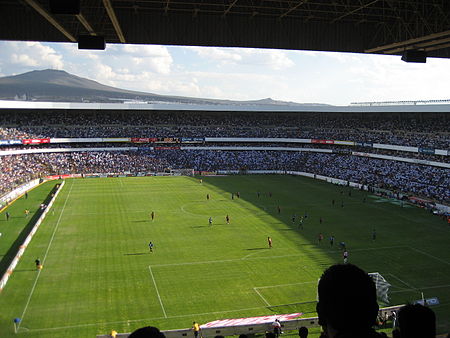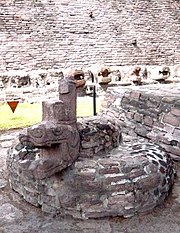Tenayuca
| |||||||||||||||||||||||||||||||||||||
Read other articles:

Elections to the Baseball Hall of Fame This article needs additional citations for verification. Please help improve this article by adding citations to reliable sources. Unsourced material may be challenged and removed.Find sources: 1993 Baseball Hall of Fame balloting – news · newspapers · books · scholar · JSTOR (October 2019) (Learn how and when to remove this message) 1993 Baseball Hall of Fame ballotingNew inductees1via BBWAA1Total inductees216Induc…

密西西比州 哥伦布城市綽號:Possum Town哥伦布位于密西西比州的位置坐标:33°30′06″N 88°24′54″W / 33.501666666667°N 88.415°W / 33.501666666667; -88.415国家 美國州密西西比州县朗兹县始建于1821年政府 • 市长罗伯特·史密斯 (民主党)面积 • 总计22.3 平方英里(57.8 平方公里) • 陸地21.4 平方英里(55.5 平方公里) • �…

For other uses, see Untouchable (disambiguation). Outcaste redirects here. For other uses of outcast, see Outcast (disambiguation). Discriminatory practices against certain social groups Part of a series onDiscrimination Forms Institutional Structural Statistical Taste-based Attributes Age Caste Class Dialect Disability Genetic Hair texture Height Language Looks Mental disorder Race / Ethnicity Skin color Scientific racism Rank Sex Sexual orientation Species Size Viewpoint Social Aropho…

Multi-purpose stadium in Kampala, Uganda For the stadium located in Algeria, see Nelson Mandela Stadium. For the stadium in South Africa, see Nelson Mandela Bay Stadium. Mandela National StadiumNamboole StadiumFans leaving Mandela National Stadium in 2019Mandela National StadiumLocation within UgandaFull nameMandela National StadiumFormer namesNamboole National Stadium (1997–2013)LocationBweyogerereKira MunicipalityCentral RegionUgandaCoordinates00°20′52″N 32°39′33″E / &#…

Chiesa Nuova setelah restorasi (2002). Santa Maria in Vallicella, juga disebut Chiesa Nuova, adalah sebuah gereja di Roma, Italia, yang sekarang menghadap ke bagian utama Corso Vittorio Emanuele dan persimpangan Via della Chiesa Nuova. Gereja tersebut adalah gereja utama dari Oratorian, sebuah kongregasi agama dari para imam sekuler, yang didirikan oleh Santo Filipus Neri pada 1561 pada abad ke-16 saat Kontra Reformasi menimbulkan pendirian sejumlah organisasi keagamaan baru seperti Serikat Yesu…

مراد علي سفلي تقسيم إداري البلد إيران إحداثيات 37°25′36″N 45°12′00″E / 37.42666667°N 45.2°E / 37.42666667; 45.2 السكان التعداد السكاني 194 نسمة (إحصاء 2016) تعديل مصدري - تعديل مراد علي سفلي هي قرية في مقاطعة أرومية، إيران.[1] يقدر عدد سكانها بـ 194 نسمة بحسب إحصاء 2016.[2] مر�…

Member of the Cabinet of the United Kingdom For equivalent positions in other countries, see Leader of the House (disambiguation). This article needs additional citations for verification. Please help improve this article by adding citations to reliable sources. Unsourced material may be challenged and removed.Find sources: Leader of the House of Lords – news · newspapers · books · scholar · JSTOR (May 2010) (Learn how and when to remove this message) Uni…

Swedish truck manufacturer Volvo TrucksCompany typeDivisionIndustryAutomotiveFounded1928HeadquartersGothenburg, SwedenAreas servedWorldwideKey peopleRoger Alm (President)ParentVolvoWebsitevolvotrucks.com A 2013 model Volvo FH16. The Volvo FH series was introduced in 1993 and is Volvo Trucks' most commercially successful truck. Volvo FM500 in Taiwan Volvo Trucks (Swedish: Volvo Lastvagnar) is a truck manufacturing division of Volvo based in Gothenburg, Sweden. Volvo Trucks was a separate company …

Приходская церковь в Лидсе Приходска́я церковь — христианский храм, который действует в качестве духовного центра прихода[1], являющегося административно-территориальной единицей епископальной системы церковного управления. Как правило, приходской церковью наз�…

Mountain range of the Transverse Ranges in California, United States San Gabriel MountainsSummits in the eastern San Gabriel Mountains, Angeles National Forest, San Bernardino County, California. The main peaks are: Telegraph Peak 8,985 feet (2,739 m) (left), Cucamonga Peak, 8,859 feet (2,700 m) (center), and Ontario Peak 8,693 feet (2,650 m) (center right), as seen from Baldy Bowl on Mount Baldy.Highest pointPeakMount San AntonioElevation10,069 ft (3,069 m)Coordina…

U.S. House district for Maine Maine's 2nd congressional districtMaine's 2nd congressional district since January 3, 2023Representative Jared GoldenD–LewistonDistribution72.11% rural27.89% urbanPopulation (2022)687,642Median householdincome$59,676Ethnicity90.9% White4.0% Two or more races1.7% Hispanic1.5% Black0.8% Asian0.8% Native American0.3% otherCook PVIR+6[1] Maine's 2nd congressional district is a congressional district in the U.S. state of Maine. Covering 27,326 square mile…

Ilocos Norte's 1st congressional districtConstituencyfor the House of Representatives of the PhilippinesLocation of Ilocos Norte within the PhilippinesProvinceIlocos NorteRegionIlocos RegionPopulation305,774 (2015)[1]Electorate434,114 (2022)[2]Major settlements 12 LGUs Cities Laoag Municipalities Adams Bacarra Bangui Burgos Carasi Dumalneg Pagudpud Pasuquin Piddig Sarrat Vintar Area2,047.42 km2 (790.51 sq mi)Current constituencyCreated1907RepresentativeSandro Marco…

Ferdinando Petruccelli della Gattina Deputato del Regno d'ItaliaLegislaturaVIII, XII, XIII, XIV CoalizioneSinistra storica Sito istituzionale Dati generaliPartito politicoSinistra storica Titolo di studiolaurea UniversitàUniversità degli Studi di Napoli Federico II ProfessioneScrittore Ferdinando Petruccelli della Gattina (Moliterno, 28 agosto 1815 – Parigi, 29 marzo 1890) è stato un giornalista, scrittore, patriota e politico italiano. Prolifico scrittore di idee liberali e …

Attentato all'incrocio di KarkurattentatoTipoattacco suicida Data21 ottobre 2002 Luogoincrocio di Karkur, Israele Stato Israele Coordinate32°27′54″N 34°59′38″E32°27′54″N, 34°59′38″E ResponsabiliJihad islamica palestinese ConseguenzeMorti7 civili, 7 soldati e 2 attentatori suicidi Feritioltre 40 Modifica dati su Wikidata · Manuale L'attentato all'incrocio di Karkur fu un attacco suicida avvenuto il 21 ottobre 2002 allo svincolo di Karkur nel Wadi 'Ara, in Israele. L…

Charlie Chan Warner Oland dans le rôle de Charlie Chandans Charlie Chan's Secret Origine Américain d'origine chinoise Activité Détective Créé par Earl Derr Biggers Interprété par Warner OlandSidney TolerRoland WintersPeter Ustinov Première apparition La Maison sans clef (1925) Dernière apparition Le Gardien des clés (1932) modifier Charlie Chan, est un personnage de fiction créé en 1925 par Earl Derr Biggers, c'est un détective américain d'origine chinoise . Il est le héros…

Main article: 2024 United States presidential election 2024 United States presidential election in Vermont ← 2020 November 5, 2024 2028 → Nominee Joe Biden(presumptive) Donald Trump(presumptive) Party Democratic Republican Home state Delaware Florida Running mate Kamala Harris(presumptive) TBA Incumbent President Joe Biden Democratic Elections in Vermont Federal government Presidential elections 1792 1796 1800 1804 1808 1812 1816 1820 1824 1828 1832 1836 18…

Yamaha Xabre Yamaha Xabre (2016)ProdusenYamaha Motor CompanyJuga disebutYamaha M-Slaz (Thailand)Yamaha TFX150 (Filipina dan Vietnam)[1]Perusahaan indukYamaha CorporationTahun Produksi2015-sekarangKelasMotor sportMesin149,8 cc (9,14 cu in) silinder tunggal, 4-langkah, berpendingin cairan, SOHC, 4-katupSistem transmisi6-percepatan constant meshSuspensiDepan: Teleskopik terbalikBelakang: Lengan ayun aluminium dengan peredam kejut tunggalRemDepan: Cakram hidrolik dengan piston…

Untuk fisikawan, lihat Robert Coleman Richardson. Robert RichardsonRobert Richardson 2019LahirRobert Bridge Richardson27 Agustus 1955 (umur 68)Hyannis, Massachusetts, Amerika SerikatKebangsaanAmerikaPekerjaanSinematograferTahun aktif1982—sekarangGelarASCSuami/istriMonona WaliStephanie MartinAnakKanchan Wali-RichardsonMaya Wali RichardsonBibi Haberstock RichardsonMadeleine Martin RichardsonPenghargaanAcademy Award untuk Sinematografi TerbaikJFK, 1991The Aviator, 2004Hugo, 2011 Robert …

Stdion La CorregidoraEl Coloso del Cimatario LokasiLokasiAvenida Luis Vega Monroy 409-4, Querétaro, MeksikoKonstruksiDibuat1984Dibuka5 Februari 1985ArsitekLuis Alfonso FernandezData teknisPermukaanRumputKapasitas33.162[1]Ukuran lapangan105 × 70 mPemakaiQuerétaro F.C. (1985–kini)Cobras (1986-1987)Atlante (1989-1990)Tampico Madero (1994-1995)Universidad Nacional (1999-2000)Sunting kotak info • L • BBantuan penggunaan templat ini Stadion Corregidora adalah sebuah stadion …













